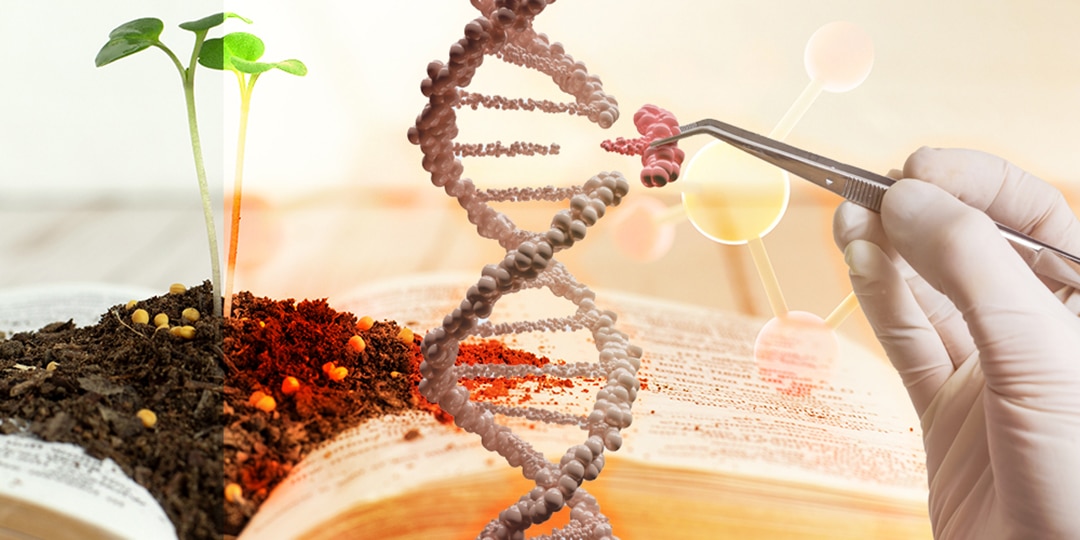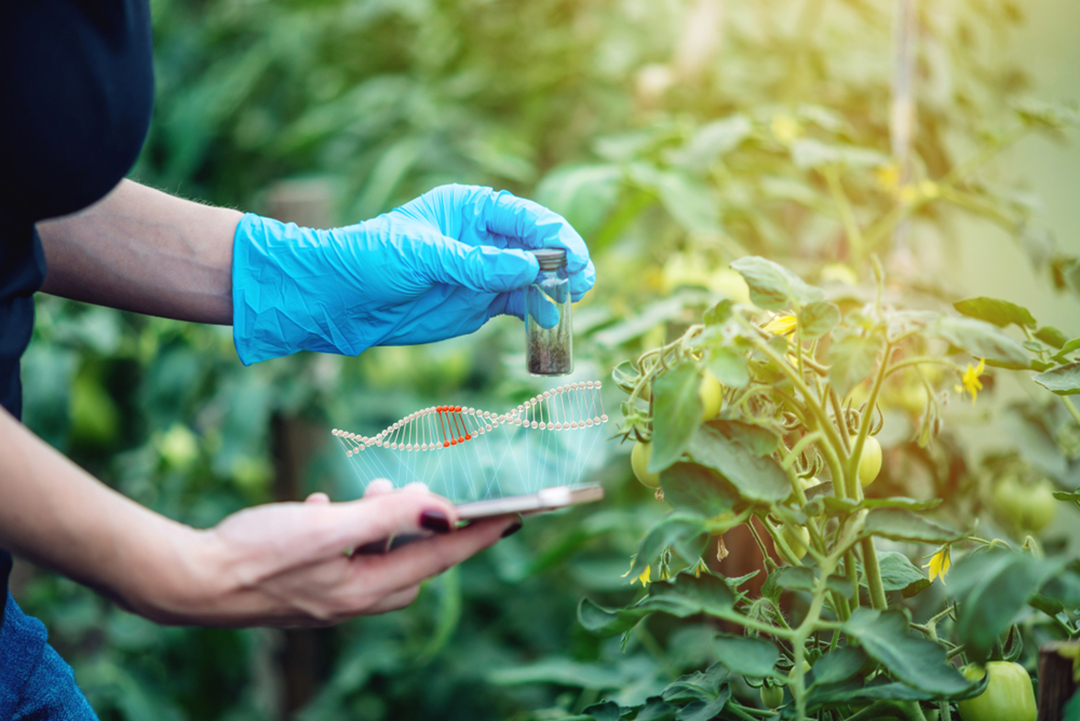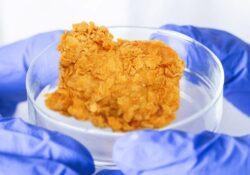

Gene edited foods in our shops soon? Reality vs hype
by Pat Thomas | Mar 7, 2023
The Genetic Technology (Precision Breeding) Bill passed through parliament last night on the promise that agricultural gene editing technology – what the UK government is calling “precision breeding” – will create a cornucopia of crops and animals that are higher yielding, require fewer pesticides and fertilisers, are resistant to disease and drought, can fight food waste and are safer and more nutritious[1].
Examples used by Defra in its briefs to parliamentarians and media releases include climate-resistant wheat, non-browning bananas, and disease resistant chickens[2]. Elsewhere it has promoted sugar beet immune to virus yellow, wheat that is resilient to climate change and has lower levels of asparagine, tomatoes re-engineered to contain vitamin D and disease resistant pigs[3].
The most recent House of Commons research briefing[4] says:
“Examples of current GE products include soybean oil with reduced saturated fat sold in the USA and a tomato sold in Japan that accumulates a chemical that lowers blood pressure. For the future, a range of wheat, chickpea, and peanut products with health benefits are in development, alongside products aimed at consumer convenience such as seedless fruits and corn that is higher in thickening starch.”
No such crops exist or are anywhere near being commercialised. Yet, the official narrative around the bill promotes gene editing as both a food security imperative[5] – to protect the UK from shortages due to the war in Ukraine[6] – and a near mythical Brexit benefit: “the first step in securing our future food security as a nation[7].”
The notion of what ‘other countries’ are doing and fear of being left behind – in scientific development and in the marketplace – is also a key part of this narrative. Thus Science Minister George Freeman‘s recent we’re-open-for-business remarks about turning the UK into “a global testbed[8]” for agritech, gene edited crops and synthetic biology amongst other technologies. Media outlets also touted the Brexit benefits of gene edited non-browning mushrooms[9] even though a) these never made it to market and b) halfway through the Lords process the government was forced to admit that the scope of the bill – as wide as it was – fails to include mushrooms[10].
Given this, it seems important to clarify the commercial status of plants and animals created using gene editing techniques.
Not so new
Although they are touted as ‘new’, gene editing techniques such as CRISPR, TALENs, ODM and ZFN have been in use for more than a decade in experimental plant and animal breeding. Press releases celebrating the approval of gene-edited crops and animals by individual governments, often precede any actual planting or market sales by years, sometimes decades. As such it is frustrating that government spin doctors and an obedient media so often erroneously equate being approved for sale with actually being on sale.
Often, further testing is required post-approval, or companies may not have the funds to further develop their products. Interest from farmers can be low and new opportunities for sales can be difficult to identify and, in an marketplace crowded with better or more familiar alternatives, lack of consumer interest can mean products never advance to market.
In reality, although several gene-edited crops and a few animals have been approved for commercialisation over the last decade, particularly in the US and Japan, few have made it to market and most have been abandoned, often without a single clear explanation as to why.
What products are out there?
In June 2022, then Defra Secretary of State George Eustice claimed that food containing gene edited crops could be in shops as early as next year[11]. This was a lie. It also contradicted a statement made six months earlier by the Defra Chief Scientist, Gideon Henderson, who offered the opinion that gene edited crops in the UK were “five years away”[12]. Even this is probably stretching the truth.
Here’s where things stand:
High oleic acid soybean oil
US biotech company Calyxt’s high oleic soybean cooking oil (Calyno) was gene edited TALENs. It was given pre-market approval in the US in 2018. In 2019 it became the first gene edited food product on the market. It was grown in small quantities in the US Midwest and had a limited market in fast-food outlets and restaurants there.
Its altered fatty acid profile (80% oleic acid, zero grams of trans fat per serving and up to 20% lower saturated fatty acids than conventional soybean oil) made it particularly heat-stable and gave it a longer shelf life, and crucially a longer fry life which meant that foods could be fried in it for longer before a change of oil was required.
In early 2020 the company offered its “chef quality oil” – which was also given a qualified heart healthy claim by the FDA[13]– for sale to consumers via its direct-to-consumer e-commerce platform[14]. Calyxt soybeans have also been used to produce a high oleic soybean meal for use in livestock feed.
An attempt to raise revenue via share issues 2020 was not entirely successful and by the end of 2020 a report by the investment magazine Seeking Alpha[15] noted “the company disappointed investors with delayed product launches and slow growth” and that there also has been slow adoption by farmers, which had been “hindered by lower crop yields, an issue seen in other genetically engineered soybean seeds.”
In late 2021, the company said in a US Securities and Exchange Commission filing[16] its management had “concluded there is substantial doubt regarding its ability to continue as a going concern”. By the fourth quarter of 2022 the company’s financials seemed untenable[17] and in January 2023 the company has recently merged with Cibus (see below) to become a new entity Cibus Inc.
Herbicide tolerant oilseed rape
Canadian company Cibus developed an oilseed rape (Canola SU), tolerant to the sulfonylurea herbicides tribenuron-methyl and thifensulfuron-methyl.
It was created using the gene editing technique oligonucleotide-directed mutagenesis (ODM) and approved for sale in US in 2013 and Canada in 2014[18]. From 2016 it was grown in limited quantities in North Dakota and Montana and seeds were first sold in the US in 2016. It was grown in Canada for the first time in 2018.
That year the company sought to raise further funding for development through share issues[19]. In 2019 it relaunched Canola SU under the Falco brand along with three other SU crops[20].
Canola SU has failed to make any significant progress in the marketplace. It has also been the subject of controversy in terms of the process used to create it – much of this initiated by the company itself. Although its oilseed rape is listed as a product of genome editing in the Clearinghouse of the UN Convention on Biological Diversity[21], Cibus has been inconsistent in the way it describes the seed.
On the one hand, Cibus liked to say that Canola SU was the first commercial seed product produced using a gene-editing tool. On the other hand it has sought to downplay the role gene editing played in its creation, claiming the genetic change could be the result of “spontaneous somaclonal variation” (spontaneous mutation)[22], making it indistinguishable from conventional oilseed rape.
However in September 2020, an open-source detection test that could detect the gene editing tool in Canola SU was announced[23]. The work was funded by a consortium of NGOs and non-GM industry food companies[24] and effectively refutes claims by the biotech industry and some regulators that new crops engineered with gene editing are indistinguishable from similar, non-GM crops and therefore do not need to be regulated.
That same year Cibus announced a restructure of its business with a focus on developing traits in a handful of key crops: canola, rice, soybean, corn and wheat. As part of the strategic refocus, Cibus has divested its canola seed breeding assets to Farmers Business Network (FBN) Canada, a wholly owned subsidiary of FBN[25].
Since then Canola SU appears not to have been on sale through Cibus or FBN[26].
GABA tomato
Japan granted approval in December 2020 for the first gene edited tomatoes to be used in food production. Developed by Sanatech Seed[27], a startup from the University of Tsukuba, and created using the gene editing technology CRISPR, the Sicilian Rough tomato claims health benefits, due to higher concentrations of the amino acid GABA (gamma-aminobutyric acid) than can be found in conventionally-bred tomatoes.
GABA is a naturally occurring plant compound found at low levels in a wide range of plant foods. Sanatech claims regular consumption of its tomato can contribute to lower blood pressure and promote relaxation. This has raised some eyebrows in the research community, given the paucity of evidence supporting GABA as a health supplement[28]. However, this is not a benefit to consumers who don’t have high blood pressure and as some researchers have pointed out unintended sedative effects may be detrimental to some[29]. Japan’s Consumer Affairs Agency (CAA) has nevertheless allowed a functional claim for the tomatoes[30].
In tomatoes and other plants GABA performs multiple roles: it influences, for instance, plant growth, resistance to plant pests and diseases and stress due to temperature extremes as well as several other metabolic responses. There is no evidence that the developers investigated the plants or possible unintended environmental effects.
The wider market for the tomatoes in Japan is uncertain. The company originally promoted them by sending free seedlings (via Pioneer Ecoscience[31]) to grow in home vegetable gardens before its late 2021 roll out to contracted farmers[32]. Rather than selling through supermarkets the company has decided, initially, on a direct-to-consumer route[33]. The high GABA tomatoes must be ordered from Sanatech as puree, fruit or seedlings[34]. There are also plans to produce a dried tomato powder.
Consumer enthusiasm for the tomatoes is low. A survey of about 10,000 people by the University of Tokyo found that 40-50% did not want to eat gene edited crops or animal products, with just 10% showing interest in trying them[35].
Slick cattle
In March 2022, the Center for Veterinary Medicine (CVM) of the US Food and Drug Administration (FDA) determined that a gene-edited, heat-tolerant cattle, created by Acceligen Inc using CRISPR, posed a “low risk to humans, animals, the food supply, and the environment[36]”, opening the door to its commercialisation.
This was the first such determination for a gene edited food-use animal in the US. These cattle, called PRLR-SLICK cattle, produce a short and slick hair coat due to a modification made to the prolactin receptor (PRLR) gene. This slick coat gives cattle the ability to regulate body temperature more effectively in hot climates. Mitigating the effects of heat stress is beneficial for livestock operations in sub-tropical and tropical climates (where cattle production is expected to grow exponentially to “feed the world”[37]) and might mitigate the predicted negative effects on productivity associated with climate change[38].
There is no date for when these cattle might be put on the market and the voices of often poor farmers in sub-tropical and tropical regions is decidedly missing from the discussion.
Of note is that Acceligen is a subsidiary of Recombinetics – the firm previously castigated by the US FDA for failing to properly test its TALENs gene edited polled (hornless) cattle for traces of foreign (bacterial) DNA[39]. Brazil[40] and the US have since abandoned plans to breed the hornless dairy cattle[41]. Research continued in secret in Australia[42] but eventually some, but not all of the 11 experimental cattle were destroyed; two females were reportedly kept for breeding, but their fate since that time is not entirely clear[43].
High yield sea bream
Sea bream (madai) accounts for around 10% of the total value of Japanese aquaculture and is, therefore, an important food product in that country. In 2021 a gene-edited sea bream, created by startup Regional Fish Institute Ltd, was approved for commercialisation in Japan and claimed to be the first gene-edited animal food approval in the world.
CRISPR was used to knock out the gene for myostatin production (Pm-mstn), which normally suppresses muscle growth. The resulting fish has 20-60% more edible meat and claims to be 14% (or more[44]) more efficient at converting feed to edible body mass. Japanese media claims the fish are in the ‘marketplace’, but no concrete details exist to confirm this. A media release by the start-up says the company has been offering the product direct-to-consumer, via its website, since December 2021[45].
High yield pufferfish
A second gene-edited fish species was developed in 2021 in Japan – also by the Regional Fish Institute Ltd – and approved for commercial production. A tiger puffer (22-seiki fugu) had four leptin receptor genes knocked out using CRISPR technology. Those receptor genes control appetite and, when removed, result in a fish with enhanced appetite and therefore weight gain. The gene-edited puffer fish are about twice as heavy at the same growth stage as non-edited fish.[46] As with the sea bream, there are no clear details about the commercialisation of this fish though, again, a media release says the company has been offering the product direct-to-consumer, via its website, since December 2021[47].
High yield tilapia
The engineered tilapia (FLT 01) was exempted from regulation by Argentina’s National Advisory Commission on Agricultural Biotechnology (CONABIA)[48] in 2018. It was being developed by Intrexon and its part-owned subsidiary AquaBounty (the firm behind the controversial AquAdvantage transgenic GMO salmon[49]produced in the US and Canada). It claims to have an improved fillet yield of 70%, a growth rate improvement of 16% and a feed conversion rate improvement of 14%.
The developers further claim that the quick growth rate and shortened time to harvest, not only reduces input costs, but increases production output and reduces risk of disease.
Despite promises that it would be the first gene edited animal consumed anywhere in the world, it is still not on sale anywhere and there is no detail available about what stage of development this gene edited fish is at. In part, this may be because of the instability of the parent companies. AquaBounty has been more or less in the financial doldrums[50]since its launch and in 2019 was bought by TS AquaCulture[51]. The company has also been the subject of multiple accusations of safety violations at its GM salmon plant[52]. In 2020 Intrexon began restructuring and selling off some of its subsidiaries and changed its name to Precigen[53].
The big con
These are just the most prominent examples. There have been other promised products that have ‘failed to launch’ – and in countries where regulators have done everything possible to smooth the road to market. The bottom line is that gene edited organisms are handicapped both by the incomplete science behind them and the reckless boom-and-bust business model that underpins them.
We have to hold space for the possibility that there might be some ‘super-secret’ gene edited crops and animals being developed right now that will simply be ushered onto the market via the new English regulations (and, of course, any existing crops are now open to sell into the English market – a possible boon to developers that have run out of road elsewhere). All kinds of chicanery is at play. For instance, with field trials of Rothamsted’s much-hyped transgenic low acrylamide GMO wheat, the developers are actively looking for plants that might emerge from the large number of plants grown which they can reclassify as gene-edited[54] and slip under the regulatory radar using the new rules.
Inasmuch as this is true, we should remain vigilant and should continue to insist on mandatory labelling of all gene edited foods[55] and push what many believe will be a new government in a year’s time to come up with a stronger regulatory framework – one that that actually works for everyone and not just the biotech industry.
But as it stands, pinning our food and farming hopes on a combination of uncertainty, hype and instability, making promises that far outstrip what the technology is capable of delivering – and actively suppressing dissenting views, as Defra has been doing – makes the UK look less like a global frontrunner and more like a desperate grifter looking to score just enough short-term cash or kudos to get them to the next big con.
Subscribe to Beyond GM
References
[1] https://www.gov.uk/government/news/genetic-technology-bill-enabling-innovation-to-boost-food-security. See also https://hansard.parliament.uk/commons/2023-03-06/debates/EE119F6F-B84E-4901-A804-8589C001F567/GeneticTechnology(PrecisionBreeding)Bill
[2] https://www.gov.uk/government/news/genetic-technology-bill-to-take-on-most-pressing-environmental-problems-of-our-time
[3] https://publications.parliament.uk/pa/bills/cbill/58-03/0011/PBBillFactSheetCaseStudies.pdf. See also https://publications.parliament.uk/pa/bills/cbill/58-03/0011/FactsheetGenetic.pdf
[4] https://researchbriefings.files.parliament.uk/documents/CBP-9557/CBP-9557.pdf
[5] https://www.gov.uk/government/news/genetic-technology-bill-enabling-innovation-to-boost-food-security
[6] https://www.telegraph.co.uk/news/2022/05/22/gene-edited-crops-sped-ease-ukraine-food-crisis
[7] https://deframedia.blog.gov.uk/2022/05/25/media-coverage-of-government-plans-to-introduce-genetic-technology-precision-breeding-bill
[8] https://www.politico.eu/article/british-science-will-focus-on-key-areas-if-blocked-from-eu-schemes-post-brexit
[9] https://inews.co.uk/news/politics/gene-edited-products-supermarkets-george-eustice-1641349
[10] https://hansard.parliament.uk/lords/2022-12-12/debates/AE904A12-2F68-4992-8BCE-AF885A45DE8B/GeneticTechnology(PrecisionBreeding)Bill#contribution-3ECC994C-FFAE-4A74-B084-035D9F8E1040
[11] https://www.cieh.org/ehn/public-health-and-protection/2022/june/government-and-scientists-clash-over-gene-editing
[12]https://www.newscientist.com/article/2305284-gene-edited-food-is-5-years-away-in-england-says-government-scientist
[13] https://www.todaysdietitian.com/news/091317_news.shtml
[14] https://calyxt.com/calyxt-launches-consumer-e-commerce-channel-for-calyno-premium-cooking-oil. See also https://calyxt.com/calyxt-launches-consumer-e-commerce-channel-for-calyno-premium-cooking-oil
[15] http://web.archive.org/web/20220120231259/https://seekingalpha.com/article/4394048-calyxt-to-exit-farming-operations-and-focus-on-seed-science
[16] https://www.sec.gov/Archives/edgar/data/1627281/000119312522064482/d210703d20f.htm
[17] https://www.prnewswire.com/news-releases/calyxt-reports-fourth-quarter-2022-financial-results-and-provides-corporate-update-301761208.html
[18] https://www.cibus.com/press-release.php?date=031814
[19] https://www.businesswire.com/news/home/20180626006132/en/Cibus-Raises-70M-in-Series-C-Funding. See also https://www.sec.gov/Archives/edgar/data/1753203/000114036118043296/s002439x4_s1.htm
[20] https://www.topcropmanager.com/cibus-launches-new-canola-varieties-under-seed-brand-falco/
[21] http://bch.cbd.int/database/record.shtml?documentid=110268
[22] https://www.greenpeace.org/eu-unit/issues/nature-food/45028/gene-edited-crop-cant-stand-the-light-of-day
[23] https://www.mdpi.com/2304-8158/9/9/1245
[24] Development of the test was led by Dr John Fagan at the Health Research Institute (Iowa, USA). It was funded by NGOs Greenpeace European Unit and Greenpeace Germany, and the Sustainability Council of New Zealand; associations for non-GM foods VLOG (Germany), ARGE Gentechnik-frei (Austria) and the Non-GMO Project (USA); the Organic and Natural Health Association (USA); organic food and farming association IFOAM Organics Europe; and Austria’s leading retailer SPAR.
[25] https://www.businesswire.com/news/home/20201029005432/en/Cibus-Sharpens-Corporate-Focus-to-Concentrate-on-the-Five-Major-Input-and-Agronomic-Trait-Markets-in-the-Five-Major-High-Yielding-Crops-Divests-its-Canola-Seed-Business
[26] https://www.gmwatch.org/en/106-news/latest-news/20142-has-another-gene-edited-pioneer-crop-disappeared-from-the-market
[27] https://sanatech-seed.com/en/20201211-2-2
[28] https://www.scientificamerican.com/article/crispr-edited-tomatoes-are-supposed-to-help-you-chill-out/
[29] https://www.testbiotech.org/en/limits-to-biotech/crispr-tomatoes/basic_paper
[30] https://sanatech-seed.com/en/221226-2
[31] https://www.p-e-s.jp/news/20211011. See also https://sanatech-seed.com/en/about-en/next-phase
[32] https://japan-forward.com/a-new-era-for-food-the-potential-benefits-of-gene-edited-foods
[33] https://sanatech-seed.com/en/about-en/next-phase/
[34] https://aozora-shop.p-e-s.co.jp/products/list?category_id=&name=gaba.
[35] https://www.greens-efa.eu/files/assets/docs/chapter_7_gene_editing_is_not_a_fast_or_reliable_route_to_desired_outcomes.pdf
[36] https://www.fda.gov/news-events/press-announcements/fda-makes-low-risk-determination-marketing-products-genome-edited-beef-cattle-after-safety-review
[37] https://www.ncbi.nlm.nih.gov/pmc/articles/PMC7023624
[38] https://www.jdsupra.com/legalnews/fda-clears-crispr-edited-cattle-for-6721856
[39] https://www.nature.com/articles/s41587-019-0394-6. See also https://www.nature.com/articles/s41587-020-0413-7
[40] https://www.wired.com/story/brazils-plans-for-gene-edited-cows-got-scrappedheres-why
[41] https://www.wired.com/story/brazils-plans-for-gene-edited-cows-got-scrappedheres-why
[42] https://www.foe.org.au/miracle_cows_highlight_risks_of_gene_editing
[43] https://www.abc.net.au/news/2020-03-14/genetically-modified-cows-no-horns-in-australia/12018078
[44] https://www.sciencedirect.com/science/article/abs/pii/S0044848620311467?via%3Dihub
[45] https://prtimes.jp/main/html/rd/p/000000010.000060432.html
[46] https://www.fao.org/3/cc3579en/cc3579en.pdf
[47] https://prtimes.jp/main/html/rd/p/000000010.000060432.html
[48] https://thefishsite.com/articles/gene-edited-tilapia-secures-gmo-exemption
[49] https://agfundernews.com/aquabounty-in-murky-water-after-evidence-shows-safety-violations-at-ge-salmon-plant
[50] https://seekingalpha.com/article/4535919-aquabounty-stock-not-casting-a-lure-yet
[51] https://www.cpacanada.ca/en/news/pivot-magazine/2020-07-02-aquabounty-bioengineered-salmon
[52] https://agfundernews.com/aquabounty-in-murky-water-after-evidence-shows-safety-violations-at-ge-salmon-plant
[53] https://www.biospace.com/article/intrexon-changes-name-to-precigen-taps-new-ceo
[54] http://www.labnews.co.uk/article/2092835/a-guarantee-of-security




